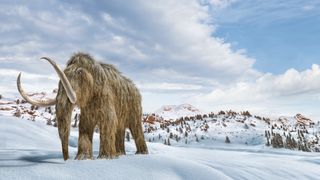Woolly mammoths weren't always shaggy. Here's when they evolved some of their trademark features.
Genetic testing of 23 woolly mammoths shows that they weren’t always so furry.

Woolly mammoths weren't always the shaggy beasts depicted in books and movies. And now, scientists have a better idea of when these behemoths evolved some of their most iconic traits.
Researchers from Sweden compared the genomes of 23 Siberian woolly mammoths (Mammuthus primigenius) to the genomes of 28 modern-day Asian elephants (Elephas maximus) and African elephants (Loxodonta). They found that over the course of the megafauna's more than 700,000 years of existence, its "trademark features" — such as woolly fur, small ears and large fat deposits — evolved too, according to a study published April 7 in the journal Current Biology.
"We wanted to know what makes a mammoth a woolly mammoth," lead author David Díez del Molino, a paleontologist at the Centre for Palaeogenetics in Stockholm, said in a statement. "Woolly mammoths have some very characteristic morphological features, like their thick fur and small ears, that you obviously expect based on what frozen specimens look like, but there are also many other adaptations, like fat metabolism and cold perception, that are not so evident because they're at the molecular level."
Related: The CIA wants to bring woolly mammoths back from extinction
The researchers found that "overall, the [more than] 700,000-year-old Chukochya genome, which represents one of the earliest woolly mammoths, shared approximately 91.7% of the mutations that caused protein-coding changes in the more modern woolly mammoths." That means the species' defining traits — such as fluffy fur, fat deposits and ability to weather cold conditions — were present when the woolly mammoth diverged from the steppe mammoth (Mammuthus trogontherii), one of its ancestors, according to the statement.
They also discovered that woolly mammoths evolved to have dry earwax and a reduction in body odor, according to the study.
"We found some highly evolved genes related to fat metabolism and storage that are also found in other Arctic species like reindeer and polar bears, which means there's probably convergent evolution for these genes in cold-adapted mammals," Díez del Molino said in the statement.
Sign up for the Live Science daily newsletter now
Get the world’s most fascinating discoveries delivered straight to your inbox.

Jennifer Nalewicki is a Salt Lake City-based journalist whose work has been featured in The New York Times, Smithsonian Magazine, Scientific American, Popular Mechanics and more. She covers several science topics from planet Earth to paleontology and archaeology to health and culture. Prior to freelancing, Jennifer held an Editor role at Time Inc. Jennifer has a bachelor's degree in Journalism from The University of Texas at Austin.
Most Popular

By Harry Baker

By Sascha Pare